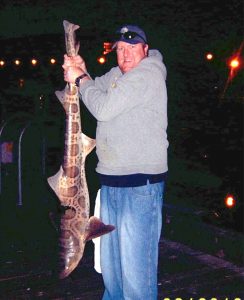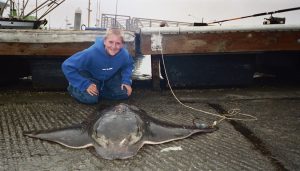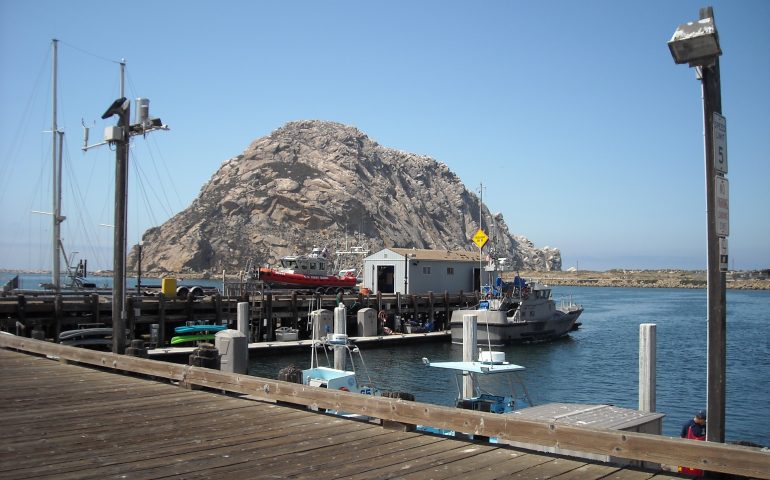
Leopard shark caught by CayucosJack (Aaron Coons) in 2004
Although the wisdom in most areas is that a big chunk of squid is the best bait for bat rays, and a bloody piece of mackerel for the sharks, here locals like to use the freshly caught pelagics (small fish or chunks of the larger fish) and they work. Again, be flexible, and experiment until you find out what is working. What I do recommend is to cast out into the deeper waters away from the pier. It’s where most of the larger fish are found AND it gives you an opportunity to play the fish for a while, and hopefully tire it out, before it is time to bring it up by the pier. Landing a big fish amongst the various pilings on a pier is never easy and here, with the various boats tied to the pier, it’s even harder. Many 50-57-inch leopard sharks, big soupfins, and bat rays in excess of a hundred pounds have been landed here. In addition, a 95-pound skate (I assume it was a big skate) was caught at the pier Christmas week of ’99. Given the heavy currents, heavy sinkers needed to combat those currents, heavy fish, and occasional globs of eel grass on the line, fairly heavy tackle is recommended if you decide to go sharay fishing.

Big bat ray — 2006
Potpourri — Perhaps More Than You Want To Know About The T-Pier
<*}}}}}}}}}>< — Although tidal conditions can indeed make both T-Piers unfishable, the waters around both piers can also offer up some almost unbelievable action at times. It’s not every year, and it’s typically only July into September, but the numbers of fish can be staggering.
My first introduction to this type of “over-the-top” action took place at the North T-Pier during a mid-August night in 1984. Upon arrival I found the night air to be cold and foggy and I quickly put on a warm jacket. 20 minutes later the wind had died down, the night had turned balmy, and it was shirtsleeve weather—9 o’clock at night. The moon was replacing the sun, and it was starting to get dark, but the Coast Guard ship anchored next to the dock had its bright lights turned on and they illuminated the water around the pier. Strangely, the water was colored red. Red tide? No! Instead, it was thousands of small bocaccio that seemed to saturate the shallow waters with their color (which is actually more bronze than red).
Dropping a small jig into the school produced a fish on every cast but soon I grew tired of that. So, I tried dropping a leader down to the bottom through the numbers of bocaccio. Now, every cast produced a small, under-sized lingcod (although a couple of small kelp bass and a gopher rockfish joined in the fun). The lingcod were evidently as thick as the bocaccio up above. It would seem like an angler’s paradise except that the fish were too small, the lingcod were illegal, and there simply wasn’t any challenge. I finally tied on a heavier sinker, put bigger hooks on the leader, and cast out from the pier to the less productive water away from the pier. The action slowed but it seemed the only thing to do.
The next such occurrence happened in July of 1994 during my annual summer trip along the coast. My initial stops, at San Simeon and Cayucos, were dismal. However, a young boy at Cayucos mentioned that anglers were catching sardines at the Morro Bay Wharf so I decided to head over and check out the action.
When I arrived, the North T-Pier was jammed with anglers, but they were having a hard time fishing. The current was extremely strong and the main catch on the angler’s multi-hook riggings was eelgrass. I decided to have some fish and chips for lunch and then see if the conditions had improved.
Less than an hour later I was back at the pier. The current had slackened and adrenalized anglers were now hauling in fish. Looking down into the water revealed an amazing sight. A vast school of fish—Pacific sardines, jack mackerel, and Pacific mackerel, seemed to clog the narrow channel that sits between the pier and shore. Anglers would cast out, begin to retrieve their line, and watch their poles begin to jerk as the fish hit. Sometimes a single fish was hooked; sometimes it was two or three. Almost always a string of fish would follow the leader to the surface. Most exciting however were the fairly huge sea lions and the somewhat smaller harbor seals that also seemed to clog the waterway. They would emerge out of the depths and never fail to startle a few of the younger anglers. And, likely as not, a fish or two would be grasped in the seal’s mouth. (A PFIC regular at Monterey’s Wharf #2 called a similar scene “seals frolicking in sardine soup.”)
The fish were as thickly packed in the water as (simile time) sardines in a can and the stem of the pier reminded one of the opening day at an urban trout pond; too many anglers and not enough space. It was a savage scene, as humans and seals contested for the fish). Nevertheless, I joined the mob and less than two hours of fishing produced 125 fish (although most were returned to the water). For some it was fantabulous fun; as to myself, I left somewhat embarrassed.
Three weeks later I was once again on Highway 101, this time heading north. I had just finished my most productive trip ever to the southern California piers, I was a little fished out (although that almost seems an oxymoron), and I was anxious to get home. But out of curiosity, I decided to swing over from San Luis Obispo to Morro Bay. People were still catching fish! I decided to fish for one hour to get some fresh bait to take home. That one-hour produced 81 fish and a new feeling of guilt as I repacked my rod and reel. I don’t know how long the fish were present that summer, or how many fish were caught, but the numbers seem scary when discussing the normal decrease in fish along the coast.
I guess that guilt had passed by the time I noticed a post on the PFIC Message Board telling of similar fishing at the Bay in August of 2002. An angler reported that the sardines and jacksmelt were packing the water and that she had caught nearly 200 fish. The temperature being nearly a hundred degrees in the Valley, I headed down to Morro Bay for some cool weather and, hopefully, hot fishing, reminiscent of the 1994 trip. Turned out to be right on both counts. Arrived in town at fifteen to five, immediately enjoyed the chill from the fog, and was on the North T-Pier at five. Not as crowded as the previous trip but the fish were there—vast schools of jacksmelt and sardines. In the waters near the shore a huge school of jacksmelt (horse smelt size fish 12-16” in length) were tempting the anglers. In the open water near the edge of the pier the school of fish was mixed, both jacksmelt and sardines. Cast out a Sabiki bait rig, let it settle briefly, then pull it in—strong pull, slack, strong pull, slack, and sardines would generally hit. One, two or three fish at a time. Cast closer to the pier, let the line sink a little deeper, and then pull in slowly with a jiggle or two and the result was a jacksmelt, perhaps two, or even three at a time. Just over two hours fishing produced 152 fish—103 sardines, 48 jacksmelt and a confused little cabezon who bit a bottom hook.
Later that same night I returned after a visit to Cayucos. Arriving at the well-lit corner by the Coast Guard boat, I was immediately intrigued by the sight. Eelgrass had piled up near the pilings and the boat but in the middle of the grass was an open water circle of space approximately 30 feet in diameter. Near the top of the water were small baitfish (pinhead anchovies?) packed fairly tight and herded by what appeared to be 6-8 inch bocaccio. The bocaccio would dart up from the depth every so often and make sure the school of baitfish kept in a circular swimming pattern. Every few minutes, the school of jacksmelt, thousands of fish, would sweep through the area deeper down in the water, probably about ten feet or so under the surface. The school would turn as one and move on to reappear a few minutes later. I decided to cast my light line (rigged with two small hooks and pile worms) toward the weeds and let it drift under the weeds closer to the pilings. The result for an hour’s fishing time: 3 kelp rockfish, 2 vermilion rockfish, a lone gopher rockfish, a single brown rockfish and several shinerperch and jacksmelt. Nature at its best! And though cool, it was warmer at 11 P.M. than at 5 P.M. (Unfortunately the water in that corner of the pier now sits under deck and dock.)
A final, short visit took place the next afternoon after fishing at Avila Beach and Pismo Beach. This time I used the two hooks and pile worm approach and pulled in 25 large jacksmelt in an hour’s time (and all were released). This time there were less fish but all were big, tackle bustin’ horse smelt (slight exaggeration there). Only bad note was that by the second day the temperature at Morro Bay was as hot as the fishing so I couldn’t avoid the heat. Headed back to Lodi with a small chest of sardines and an even larger measure of guilt. What was I doing catching so many fish even if most were released back into the water? But it was fun.
<*}}}}}}}}}>< — Although I have never caught a sharpnose perch south of Monterey, apparently some do show up in Morro Bay. What is most interesting about the following excerpt of an article is the possible diurnal nature of the perch; this was a new hypothesis for me.
“Only one species seems important to single out as unusual, since it is more common than normally thought. Smith (1964), in a redescription and reanalysis of the life history of the sharpnose seaperch, described a single female specimen caught by hook-and-line from a pier in Morro Bay on July 11, 1963. This fish measured 181 mm SL and contained ten embryos. The 21 specimens collected in our survey agree with the reproductive activity and occurrence reported by Smith, however, our specimens were all caught on whole, live anchovies at a nightlight station. (Tremper, unpublished data) and might indicate nocturnal habits for this species.”
—Fierstine, Kline and Garman, Fishes Collected in Morro Bay, California Between January 1968 and December 1970, Calif. Fish and Game 1973
<*}}}}}}}}}>< — I’ve often wished I were a diver so that I could study the pilings, piling creatures, and fish under the piers. Alas, it is not to be. However, with the Internet more and more people are sharing their stories—including some divers. One such site is www.belowmorrobay.com. (Field Notes, Journal of marine observations under the Morro Bay T-Pier). On it are some excellent pictures and descriptions of life under the Morro Bay T-Pier. One mission of the site is: “to increase community awareness of & help preserve the marine treasure that exists below the Morro Bay T-Pier among the decades of accumulated junk that has formed an unintentional reef teeming with a density and variety of marine life that exists nowhere else in Morro Bay.”
One observation I found interesting is the notation that life on the pilings has changed over the years. “When we first began diving here (early 1980’s), most pilings were covered with anemones. Near the pile bottom, Metridium senile anemones abounded, and up higher, colorful congregating anemones held sway. Over the years life on the pilings has changed. Anemones have largely been replaced by red bryozoans, except in the shallow end of the pier, where large Metridium anemones still abound. We have no idea why red bryozoans have taken over most of the piling habitat or if this is just a normal cycle in the ocean. We often see nudibranchs on the red bryozoans, which makes an excellent backdrop for photography.”
Nudibranch, also known as naked snails and sea slugs, are apparently very abundant in the area (one source calls Morro Bay the Nudibranch capital of the world) and apparently thousands of them are found under and around the pier. Given the number, it’s not surprising that every so often an angler will hook one of the colorful slugs albeit they have no idea what they have caught. Generally, after getting the creature up to the pier, the surprised angler will simply exclaim, “What is this thing?”
